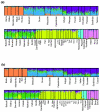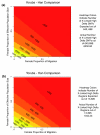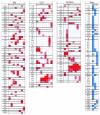Characterization of X-linked SNP genotypic variation in globally distributed human populations
- PMID: 20109212
- PMCID: PMC2847713
- DOI: 10.1186/gb-2010-11-1-r10
Characterization of X-linked SNP genotypic variation in globally distributed human populations
Abstract
Background: The transmission pattern of the human X chromosome reduces its population size relative to the autosomes, subjects it to disproportionate influence by female demography, and leaves X-linked mutations exposed to selection in males. As a result, the analysis of X-linked genomic variation can provide insights into the influence of demography and selection on the human genome. Here we characterize the genomic variation represented by 16,297 X-linked SNPs genotyped in the CEPH human genome diversity project samples.
Results: We found that X chromosomes tend to be more differentiated between human populations than autosomes, with several notable exceptions. Comparisons between genetically distant populations also showed an excess of X-linked SNPs with large allele frequency differences. Combining information about these SNPs with results from tests designed to detect selective sweeps, we identified two regions that were clear outliers from the rest of the X chromosome for haplotype structure and allele frequency distribution. We were also able to more precisely define the geographical extent of some previously described X-linked selective sweeps.
Conclusions: The relationship between male and female demographic histories is likely to be complex as evidence supporting different conclusions can be found in the same dataset. Although demography may have contributed to the excess of SNPs with large allele frequency differences observed on the X chromosome, we believe that selection is at least partially responsible. Finally, our results reveal the geographical complexities of selective sweeps on the X chromosome and argue for the use of diverse populations in studies of selection.
Figures







Similar articles
-
Looking for signatures of sex-specific demography and local adaptation on the X chromosome.Genome Biol. 2010 Jan 28;11(1):203. doi: 10.1186/gb-2010-11-1-203. Genome Biol. 2010. PMID: 20236443 Free PMC article. Review.
-
High-density single-nucleotide polymorphism maps of the human genome.Genomics. 2005 Aug;86(2):117-26. doi: 10.1016/j.ygeno.2005.04.012. Genomics. 2005. PMID: 15961272 Free PMC article.
-
Highly punctuated patterns of population structure on the X chromosome and implications for African evolutionary history.Am J Hum Genet. 2010 Jan;86(1):34-44. doi: 10.1016/j.ajhg.2009.12.002. Am J Hum Genet. 2010. PMID: 20085712 Free PMC article.
-
Microsatellite variation and evolutionary history of PCDHX/Y gene pair within the Xq21.3/Yp11.2 hominid-specific homology block.Mol Biol Evol. 2004 Nov;21(11):2092-101. doi: 10.1093/molbev/msh218. Epub 2004 Aug 5. Mol Biol Evol. 2004. PMID: 15297598
-
Tag SNP selection for association studies.Genet Epidemiol. 2004 Dec;27(4):365-74. doi: 10.1002/gepi.20028. Genet Epidemiol. 2004. PMID: 15372618 Review.
Cited by
-
A method for the analysis of 32 X chromosome insertion deletion polymorphisms in a single PCR.Int J Legal Med. 2012 Jan;126(1):97-105. doi: 10.1007/s00414-011-0593-2. Epub 2011 Jun 30. Int J Legal Med. 2012. PMID: 21717151
-
Looking for signatures of sex-specific demography and local adaptation on the X chromosome.Genome Biol. 2010 Jan 28;11(1):203. doi: 10.1186/gb-2010-11-1-203. Genome Biol. 2010. PMID: 20236443 Free PMC article. Review.
-
Genetic Differentiation of North-East Argentina Populations Based on 30 Binary X Chromosome Markers.Front Genet. 2018 Jun 13;9:208. doi: 10.3389/fgene.2018.00208. eCollection 2018. Front Genet. 2018. PMID: 29951085 Free PMC article.
-
Contrasting Patterns of Genomic Diversity Reveal Accelerated Genetic Drift but Reduced Directional Selection on X-Chromosome in Wild and Domestic Sheep Species.Genome Biol Evol. 2018 Apr 1;10(5):1282-1297. doi: 10.1093/gbe/evy085. Genome Biol Evol. 2018. PMID: 29790980 Free PMC article.
-
Analyses of X-linked and autosomal genetic variation in population-scale whole genome sequencing.Nat Genet. 2011 Jul 24;43(8):741-3. doi: 10.1038/ng.877. Nat Genet. 2011. PMID: 21775991 Free PMC article.
References
Publication types
MeSH terms
Grants and funding
LinkOut - more resources
Full Text Sources
Research Materials

